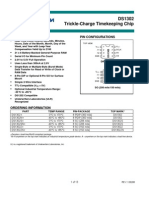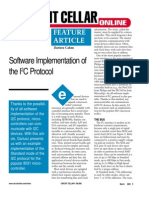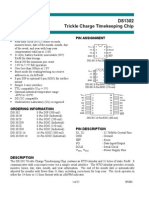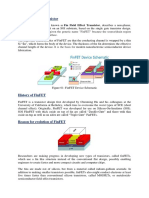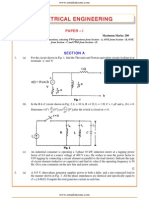AN-1248 Application Note: SPI Interface
AN-1248 Application Note: SPI Interface
Uploaded by
Biswajit SinghCopyright:
Available Formats
AN-1248 Application Note: SPI Interface
AN-1248 Application Note: SPI Interface
Uploaded by
Biswajit SinghOriginal Title
Copyright
Available Formats
Share this document
Did you find this document useful?
Is this content inappropriate?
Copyright:
Available Formats
AN-1248 Application Note: SPI Interface
AN-1248 Application Note: SPI Interface
Uploaded by
Biswajit SinghCopyright:
Available Formats
AN-1248
APPLICATION NOTE
One Technology Way P.O. Box 9106 Norwood, MA 02062-9106, U.S.A. Tel: 781.329.4700 Fax: 781.461.3113 www.analog.com
SPI Interface
by Miguel Usach
INTRODUCTION
MASTER-SLAVE COMPATIBILITY
The SPI bus interface is widely used for synchronous data
transmission because this interface allows relatively high
transmission rates with versatile configurations.
The first step is to guarantee the compatibility of the masterslave connection. The SPI interface is not an official specification, so it is important to ensure that data from the master
to the slave and/or vice versa fits within both specifications.
Although the SPI has become a de facto standard, it is not
a de jure standard; in other words, it is not officially specified.
This can sometimes be considered an advantage because the
designer can get the most from a part; however, it complicates
the interconnection between different parts.
The SPI is not a completely synchronous interface because the
data is synchronized with the clock, but CS may or may be not
synchronous.
The SPI bus consists of four unidirectional wires. The names for
these wires vary between parts, even within the same range of
products.
In a completely synchronous interface, the edges are divided
into a sampling and a driving edge. On the drive edge, the data
can be updated in the bus. On the sampling edge, the data in
the SDI/DATA IN pin is read in (sampled).
From a practical point, the data in the bus can be updated
anytime except in the sampling edge.
It is important to start by defining a convention name to avoid
confusion regarding the direction of each pin as shown in
Figure 1.
For the most part, the slave cannot be configured and can only
operate in one mode. However, sometimes it can operate in up
to two different modes.
Sometimes only three wires are needed. For example, in a DAC
it may not be necessary to read back the data, or, in the case of
an ADC, to send data. In those cases, the connection can be
defined as a 3-wire interface.
MASTER
SLAVE
SCLK
DATA OUT
DATA IN
CS
SCLK
SDI
SDO
CS
Figure 1. SPI Basic Interconnection
t10
t1
t9
SCLK
t8
t4
t3
t2
t7
CS
t5
SDI
t6
DB31
DB0
Figure 2. SPI Timing Diagram Example
Rev. 0 | Page 1 of 8
11585-002
The SPI interface defines four transmission modes. The master
should be able to support all four modes, but this needs to be
confirmed beforehand because sometimes the master is not
compatible with a particular mode. This can be overcome by
using inverters, as described in the SPI Mode Interconnection
section.
11585-001
Interface enable: CS, SYNC, ENABLE, and so on.
Data in: SDI, MISO (for master), MOSI (for slave), and
so on.
Data out: SDO, MISO(for slave), MOSI (for master), and
so on.
Clock: SCLK, CLK, SCK, and so on...
AN-1248
Application Note
TABLE OF CONTENTS
Introduction ...................................................................................... 1
When is the Bus Data Updated? ......................................................4
Master-Slave Compatibility ............................................................. 1
Are There Additional Considerations? ...........................................5
Revision History ............................................................................... 2
SPI Mode Interconnection ...............................................................6
Which Transmission Mode is Used by the Slave? ........................ 3
Topologies...........................................................................................6
REVISION HISTORY
7/13Revision 0: Initial Version
Rev. 0 | Page 2 of 8
Application Note
AN-1248
WHICH TRANSMISSION MODE IS USED BY
THE SLAVE?
The timing diagram is a figure with multiple lines and names
as shown in Figure 2.
Identifying the transmission mode is relatively easy. There is a
line that connects the CS falling edge with SCLK as shown in
Figure 4.
The mode depends on the SCLK level, sometimes called
polarity (CPOL), when the transmission is initiated (CS is
pulled low) and the sampling edge, called phase (CPHA), as
shown in Figure 3. Note that the phase is relative to the polarity
and is not an absolute value. The SPI modes are captured in
Table 1.
t1
t6
DB31
11585-005
t5
DB0
Figure 4. Polarity Mode
SCLK
In this particular case, SCLK can be high or low; there is no
restriction.
CS
11585-003
SCLK
CPHA = 1
Figure 3. SPI Timing
Table 1. SPI Modes
Mode
t7
CS
SDI
CPOL = 0
t2
t3
CPHA = 0
CPOL = 1
t9
SCLK
The SDI diagram should have a bit that is enclosed by two
timings, setup and hold. The two timings refer to the time
that the data should be present in the bus before and after the
sample edge, so both timings use the sampling edge for
reference as shown in Figure 5.
t10
Polarity (CPOL)
t1
t9
Phase (CPHA)
SCLK
0
t8
t3
t2
t7
CS
t5t5
2
11585-004
SDI
tt66
DB31
DB0
Figure 5. Phase Mode
In this case, the sample edge is falling.
Correlating the findings with Table 1, the slave part is
compatible with Mode 1 and Mode 2.
Rev. 0 | Page 3 of 8
11585-006
t4
AN-1248
Application Note
WHEN IS THE BUS DATA UPDATED?
If the pin is updated several nanoseconds after the sampling
edge, the slave has almost the full SCLK period to guarantee a
stable value of the signal in the bus so that the readback can be
done without reducing the SCLK frequency.
The SDO is used to transfer data from slave to master as well as
transferring data out from master to slave. Although the data
can be updated anytime, typically two strategies are employed.
One strategy is to update the SDO/DATA OUT pin in the
driving edge as shown in Figure 7.
The main trade-off is for slow masters because the data only is
stable in the pin several nanoseconds after the sampling edge
and the master hold time can be violated. This problem occurs
because the hold time is high, that is, >15 ns. If this is the case,
the recommendation is to use a logic gate to delay the new data
in the DATA IN pin as long as it needed as shown in Figure 6.
There are technical reasons behind both strategies, but it is
important to understand the tradeoffs.
Masters use the first strategy because the SDO drivers are
designed to support fast transitions.
SAMPLING EDGE
U1
DATA IN SCLK CS
CS
ORIGINAL
SCLK
DELAYED
Figure 6. Enable Time
Several gate technologies and typical propagation delays for a
NOR gate are shown in Table 2.
To guarantee a correct readback, the SCLK should be reduced
to guarantee that the signal is stable before the sampling edge.
Table 2. Gate Technologies and Propagation Delays
Technology
AHC
HC
HCT
For this example, assume a maximum transition time of 36 ns.
t9
SCLK
SDO
MICROCONTROLLER
If the SDO signal is updated in the driving edge, the pin has
only one-half (or even less) of a clock period to update the
signal because a signal should be stable several nanoseconds
before the sampling edge.
SDO Data Valid from SCLK
Rising Edge
SDI
DATA OUT
Slaves implement an internal SDO driver weaker than the
master, thus the strategy implemented is dependent on the data
transfer rate.
36 ns
Propagation Delay
4.4 ns
9 ns
11 ns
This mean that the maximum cycle time is 36 ns + master setup
time (assume 10 ns) = 46 ns, so the maximum SCLK frequency
for reading back is 10 MHz.
t4
t1
t2
t7
SCLK
t3
t8
tt99
C3
C2
C1
C0
D7
D6
D5
t10
D2
D1
D2
D0
11585-007
SYNC
SDO
Figure 7. SDO Driving Edge Update
CS
t8
1
18
t3
DOUT A
THREE-STATE
19
20
20
t6
2121
t7
tt4
4
DB13A DB12A DB11A
B13A DB12A DB11A
Figure 8. Delayed SDO Update
Rev. 0 | Page 4 of 8
31
32
33
t9
t5 t5
DB1A
DB0A
tQUIET
THREESTATE
11585-008
t2
SCLK
UPDATE SDO
11585-009
The other strategy is to update the SDO/DATA OUT pin several
nanoseconds after the sampling edge as shown in Figure 8.
Application Note
AN-1248
ARE THERE ADDITIONAL CONSIDERATIONS?
CS as Start Conversion Signal
Enable Time
Some ADCs, in order to reduce the pin count, and fit in
small packages, or just to reduce the routing complexity, offer
multiple functionality in a single pin.
Enable time defines how fast the SPI interface is enabled and
ready to receive or transmit data. This is typically referred to
as the SCLK sampling edge as shown in Figure 9.
When the CS is used to generate the internal start conversion
signal, there are two different case scenarios.
Disable Time
Disable time defines how fast the SPI is disabled to ignore any
new generated sampling edge transitions as shown in Figure 9.
t10
First Scenario
The SCLK signal is used as an internal clock, and continuous
SCLK is needed. In this case, the SCLK is limited between a
maximum and minimum value as shown in Table 3.
tt 9
t1
SCLK
tt44
t2
t3
t7
Table 3. Example of SCLK Frequency Limitation
Parameter
fSCLK
CS
SDI
t6
DB31
11585-010
t5
DB0
Figure 9. Enable and Disable Time
Min
0.01
Max
20
Unit
MHz
t1
CS
tCONVERT
t2t2
11
SCLK
t6
2
SDATA
ZERO
13
t4
t3
THREESTATE
Description
SCLK
frequency
There is timing, restriction, similar to the enable time described
below, in which the master cannot generate a sampling edge, or
the conversion will be corrupted, as shown in Figure 10.
ZERO
ZERO
DB11
14
DB10
15
16
t5
t7
t8
tQUIET
DB2
DB1
DB0
THREE-STATE
4 LEADING ZEROS
Figure 10.Continuous SCLK During Conversion
Rev. 0 | Page 5 of 8
11585-016
t8
AN-1248
Application Note
Second Scenario
TOPOLOGIES
The part includes an internal conversion clock. In this case, the
recommendation is to not generate SCLK pulses to reduce the
digital feedthrough impact in the LSB bits conversion as shown
in Figure 11.
The SPI interface permits different topologies allowing the
master to control one or several slaves.
CNV
tCONV
tCONV
In this configuration, there is only one slave and one master, as
shown in Figure 12.
MASTER
tACQ
CONVERSION
ACQUISITION CONVERSION
tHSDO
SDO
tQUIET
17
18
D16
tDIS
D1
D0
Figure 11. Quiet SCLK During Conversion
If the SPI interface is implemented by the hardware, rather than
an FPGA, it is not possible to have accurate control of the
SCLK and CS pin. If this is the case, the recommendation is to
use a GPIO as CS, to accurately control the relation between CS
and SCLK.
Figure 12. Standalone Configuration
Daisy-Chain Topology
In this configuration, there is one master and multiple slaves
connected in series as shown in Figure 13.
MOSI
MISO SCLK CS
SDO
SDI
CS
SCLK
SDO
U2
U1
CS
SCLK
Figure 13. Daisy-Chain Configuration
In some ADCs, the SDO provides double functionality. This
is typically noted as SDO/RDY. The SDO pin is disabled
with CS and remains at high impedance until the conversion is
completed at which point the pin is pulled low, indicating the
end of the conversion.
SPI MODE INTERCONNECTION
Sometimes because the controller cannot be configured in a
particular SPI mode used by the slave or because there is a need
to operate all the devices with the same SPI mode, that is, daisychain mode, the mode needs to be modified externally.
Consider these two cases:
SDI
MICROCONTROLLER
SDO as Conversion Ready Pin
CS
19
tSCKH
tCSDO
D17
SDO
CS
11585-013
SDI
DATA IN
11585-017
SCLK
DATA OUT
tSCK
tSCKL
SCK
SLAVE
SCLK
(QUIET
TIME)
ACQUISITION
11585-012
tCNVH
Standalone Topology
The mode is complementary where
MODE 1 = MODE 2 or MODE 0 = MODE 3
Using a inverter gate in the SCLK line the problem is fixed
The modes are not complementary.
The solution becomes a bit more elaborate, and involves
the use of inverters and flip-flops, thus the recommendation
is to avoid this because timing issues may arise.
The main benefit of this configuration is the reduced number
of connections required.
Operating in this mode, the clock period may need to be
increased because the propagation delay of the line between
subsequent devices. In addition, the number of clocks should
be increased because the required clocks are the sum of U1
and U2.
Typical transmission in a daisy-chain configuration is shown
in Figure 14. The first data-word is assigned to the last slave
connected and the last data-word is assigned to the closest slave.
There are parts that can be configured in daisy-chain mode but,
by default, the part power-up in stand-alone mode, that is, the
SDO pin does not clock out data.
In this case, the recommendation is to place the part in the
first place in the chain and enable daisy-chain mode by writing
directly to the part. Because the SDO is in high impedance
before enabling the mode, it is recommended to connect a
pull-up (or pull-low) resistor in the SDO pin to control the data
that is transferred to the second device in the chain.
Similar problems occur when the SDO pin is used for multiple
functionality, SDO/RDY. The recommendation is to place a
pull-up resistor to avoid electrical issues and continue using
the RDY functionality.
Rev. 0 | Page 6 of 8
Application Note
AN-1248
SCLK
16
17
18
32
CS
DB15
DB0
DB15
DB0
MOSI
DB15
INPUT WORD FOR U1
DB0
DB15
DB0
SDO_U1
UNDEFINED
INPUT WORD FOR U2
11585-014
INPUT WORD FOR U2
Figure 14. Daisy-Chain Timing Diagram
Parallel Configuration
In this configuration, there is one master with multiple slaves
connected in parallel as shown Figure 15.
SLAVE
MASTER
DATA OUT
SDI
As a precaution, in this configuration, the SDO may be not
disabled synchronously with SYNC in some parts, for example,
if the part is configured in daisy-chain mode.
SDO
SCK
SCLK
CS1
CS
CS2
In this case, to avoid electrical issues, the recommendation is
to not connect the SDO pin to the bus. Alternatively, if it is
possible to disable the SDO pin, place a serial resistance with
the SDO pin to minimize electrical problems in the first
transmission and disable the SDO pin at the beginning.
SLAVE
DATA IN CS3
SDO
SDI
SCLK
CS
SLAVE
SDI
In this configuration, SCLK and SDI are shared within all
the parts. Due to the parasitic net (or track) capacitance, it is
recommended to increase the clock period slightly.
SDO
CS
11585-015
SCLK
Figure 15. Parallel Configuration
Rev. 0 | Page 7 of 8
AN-1248
Application Note
NOTES
2013 Analog Devices, Inc. All rights reserved. Trademarks and
registered trademarks are the property of their respective owners.
AN11585-0-7/13(0)
Rev. 0 | Page 8 of 8
You might also like
- BC-119 BC-121 Service ManualDocument19 pagesBC-119 BC-121 Service Manualjadi purwonoNo ratings yet
- Hands-On Introduction To LabVIEW and Data Acquisition With NI CompactDAQ PDFDocument33 pagesHands-On Introduction To LabVIEW and Data Acquisition With NI CompactDAQ PDFBiswajit SinghNo ratings yet
- An, Improved Successive-Approximation Register Design For Use in A/D ConvertersDocument5 pagesAn, Improved Successive-Approximation Register Design For Use in A/D ConvertersOmer KhanNo ratings yet
- 24Lc04B/08B: 4K/8K 2.5V I C Serial EepromsDocument13 pages24Lc04B/08B: 4K/8K 2.5V I C Serial EepromsJose Antonio Lopez JuradoNo ratings yet
- Mastering The PIC16C7X A/D ConverterDocument8 pagesMastering The PIC16C7X A/D ConverterGuillermo Hernandez100% (1)
- A Phase-Locked Loop With Embedded Analog-to-Digital Converter For Digital ControlDocument7 pagesA Phase-Locked Loop With Embedded Analog-to-Digital Converter For Digital ControlAbhi BhatNo ratings yet
- Analysis of CMOS 45nm Transmission Gate Based Pulsed Latch AbstractDocument12 pagesAnalysis of CMOS 45nm Transmission Gate Based Pulsed Latch AbstractbaluNo ratings yet
- The 8085 Microprocessor Architecture: Dr. Kuda Nageswara RaoDocument32 pagesThe 8085 Microprocessor Architecture: Dr. Kuda Nageswara RaoKrishna ChaitanyaNo ratings yet
- Types of Flip FlopDocument10 pagesTypes of Flip Flopovi sahaNo ratings yet
- Registration For Wiki Conference India 2011Document21 pagesRegistration For Wiki Conference India 2011Nitya SiddagangappaNo ratings yet
- Experiment No. 3.1Document5 pagesExperiment No. 3.1Harshal AmbatkarNo ratings yet
- How To Use Intelligent L.C.D.S: Constructional FeatureDocument0 pagesHow To Use Intelligent L.C.D.S: Constructional FeatureNelu Sabie100% (1)
- Microchip MCP7940M Low Cost I2C Real Time Clock Calendar With SRAMDocument39 pagesMicrochip MCP7940M Low Cost I2C Real Time Clock Calendar With SRAM邱子威No ratings yet
- DS1320Document13 pagesDS1320Annelise Grottker de OliveiraNo ratings yet
- DS1302 Trickle-Charge Timekeeping ChipDocument13 pagesDS1302 Trickle-Charge Timekeeping ChipPravin MevadaNo ratings yet
- Adm1602k Nsa Fbs 3.3vDocument22 pagesAdm1602k Nsa Fbs 3.3vHer ManTokNo ratings yet
- Digital Wavelet Decomposition GroupDocument10 pagesDigital Wavelet Decomposition GroupkjnanduNo ratings yet
- 26354-Build A Digital PLL With Three ICs PDFDocument5 pages26354-Build A Digital PLL With Three ICs PDFReginaldo RibeiroNo ratings yet
- AtoD Converter System S12 NewDocument9 pagesAtoD Converter System S12 NewMina HannaNo ratings yet
- 8086/88 Device SpecificationsDocument22 pages8086/88 Device SpecificationsAyush PurohitNo ratings yet
- MSP Devie ErratasheetDocument8 pagesMSP Devie ErratasheetmaanviNo ratings yet
- KW950E3man PDFDocument11 pagesKW950E3man PDFPhuoc Ho NguyenNo ratings yet
- PLC Master / Slave ExampleDocument18 pagesPLC Master / Slave Examplekfathi55No ratings yet
- RFC 7323Document14 pagesRFC 7323Pranathi SepuriNo ratings yet
- I2CDocument6 pagesI2CGovinda RaoNo ratings yet
- Spi ProtocolDocument5 pagesSpi ProtocolpraveenbhongiriNo ratings yet
- Saving Costs With The SRL16EDocument22 pagesSaving Costs With The SRL16EUmar Farooq ZiaNo ratings yet
- ADS8412 As A Serial ADC - ALTERA PDFDocument11 pagesADS8412 As A Serial ADC - ALTERA PDFhieuhuech1No ratings yet
- Implementing A Source Synchronous Interface v2.0Document47 pagesImplementing A Source Synchronous Interface v2.0Gautham PopuriNo ratings yet
- TimingDocument6 pagesTimingRaj NikumbhNo ratings yet
- AVR DAC 328 TutorialDocument5 pagesAVR DAC 328 Tutorialsutekidane7435No ratings yet
- Synch Ron Is at IonDocument4 pagesSynch Ron Is at IonRahul SinghNo ratings yet
- Extending The SPI Bus For Long Distnce CommDocument7 pagesExtending The SPI Bus For Long Distnce CommFelipe Ademir Aleman Hdez100% (2)
- 24 LC 16 BDocument12 pages24 LC 16 BAnonymous UxrPsIVNo ratings yet
- Two-Wire Serial EEPROM: FeaturesDocument28 pagesTwo-Wire Serial EEPROM: FeaturesdobsrdjanNo ratings yet
- Self-Timed SAPTL Using The Bundled Data Protocol: K.V.V.Satyanarayana T.Govinda Rao J.Sathish KumarDocument8 pagesSelf-Timed SAPTL Using The Bundled Data Protocol: K.V.V.Satyanarayana T.Govinda Rao J.Sathish KumarInternational Journal of computational Engineering research (IJCER)No ratings yet
- High Speed Serial IntelDocument6 pagesHigh Speed Serial IntelNitu VlsiNo ratings yet
- S3esk Picoblaze Dac ControlDocument15 pagesS3esk Picoblaze Dac Controlkaruneee7003No ratings yet
- Low-Power and Area-Efficient Shift Register Using Pulsed Latches With CMOS TechnologyDocument6 pagesLow-Power and Area-Efficient Shift Register Using Pulsed Latches With CMOS TechnologySesharatnam KoppulaNo ratings yet
- MicrocontrollerDocument25 pagesMicrocontrollersupriyaNo ratings yet
- Sample and Hold CircuitsDocument16 pagesSample and Hold CircuitsPraveen AndrewNo ratings yet
- Chapter 3Document35 pagesChapter 3ajayroyNo ratings yet
- An All-Digital PLL Clock Multiplier: M PD OSC FilterDocument4 pagesAn All-Digital PLL Clock Multiplier: M PD OSC FilterArun JyothiNo ratings yet
- LCM Module: Industrial Co., LTDDocument18 pagesLCM Module: Industrial Co., LTDelectropicNo ratings yet
- Optical Burst Switching (OBS)Document27 pagesOptical Burst Switching (OBS)adityaNo ratings yet
- MSP 430 G 2131Document55 pagesMSP 430 G 2131Satyarth SampathNo ratings yet
- Lecture-10 Intel 8085 MicroprocessorDocument9 pagesLecture-10 Intel 8085 Microprocessorsrikaanth3811No ratings yet
- 64K 5.0V I C Smart Serial Eeprom: FeaturesDocument16 pages64K 5.0V I C Smart Serial Eeprom: FeaturesFerner BriceñoNo ratings yet
- Project DesignDocument23 pagesProject DesignpadaNo ratings yet
- An 8-Bit 200-Msample/S Pipelined Adc With Mixed-Mode Front-End S/H CircuitDocument11 pagesAn 8-Bit 200-Msample/S Pipelined Adc With Mixed-Mode Front-End S/H CircuittkbattulaNo ratings yet
- Real Time Clock: Features Pin AssignmentDocument17 pagesReal Time Clock: Features Pin AssignmentVu ThinhNo ratings yet
- DS1302 Trickle Charge Timekeeping Chip: Features Pin AssignmentDocument16 pagesDS1302 Trickle Charge Timekeeping Chip: Features Pin AssignmentJuan Isaac Rodriquez MaldonadoNo ratings yet
- Dual Edge Triggered D Flip Flop Using C MOS: Mr. Kavindra KandpalDocument21 pagesDual Edge Triggered D Flip Flop Using C MOS: Mr. Kavindra KandpalAvinash BaldiNo ratings yet
- Getting Precise With MSP430 Sigma-Delta ADC Peripherals: Vincent Chan MSP430 Business Development Manager TI AsiaDocument33 pagesGetting Precise With MSP430 Sigma-Delta ADC Peripherals: Vincent Chan MSP430 Business Development Manager TI AsiaStefanGLNo ratings yet
- A Survey On Sequential Elements For Low Power Clocking SystemDocument10 pagesA Survey On Sequential Elements For Low Power Clocking SystemJournal of Computer ApplicationsNo ratings yet
- High-Performance D/A-Converters: Application to Digital TransceiversFrom EverandHigh-Performance D/A-Converters: Application to Digital TransceiversNo ratings yet
- Projects With Microcontrollers And PICCFrom EverandProjects With Microcontrollers And PICCRating: 5 out of 5 stars5/5 (1)
- LEARN MPLS FROM SCRATCH PART-A: A Beginner's Guide to Next Level of NetworkingFrom EverandLEARN MPLS FROM SCRATCH PART-A: A Beginner's Guide to Next Level of NetworkingNo ratings yet
- You Tube LinksDocument2 pagesYou Tube LinksBiswajit SinghNo ratings yet
- GATE Notes - Operating System Part-IIDocument10 pagesGATE Notes - Operating System Part-IIBiswajit SinghNo ratings yet
- Ultra-Low Pressure Digital Sensor: SM9333/SM9336 Series Differential Pressure SensorsDocument19 pagesUltra-Low Pressure Digital Sensor: SM9333/SM9336 Series Differential Pressure SensorsBiswajit SinghNo ratings yet
- Parasitic Turn-On of Power MOSFETDocument7 pagesParasitic Turn-On of Power MOSFETBiswajit SinghNo ratings yet
- What Circuits Textbooks Haven T Told You About Feedback Amplifier and Transistor Port ImpedancesDocument9 pagesWhat Circuits Textbooks Haven T Told You About Feedback Amplifier and Transistor Port ImpedancesBiswajit SinghNo ratings yet
- Medical Fitness Criteria: For UPSC Engineering ServicesDocument6 pagesMedical Fitness Criteria: For UPSC Engineering ServicesBiswajit SinghNo ratings yet
- Gher OrderDocument29 pagesGher OrderBiswajit SinghNo ratings yet
- Adas en Ces C-S FS 160308 PDFDocument2 pagesAdas en Ces C-S FS 160308 PDFBiswajit SinghNo ratings yet
- Control System by Sujal Sir (9574234622) For GateDocument268 pagesControl System by Sujal Sir (9574234622) For GateBiswajit SinghNo ratings yet
- A Low-Cost PC-Based Virtual Oscilloscope: IEEE Transactions On Education June 2004Document6 pagesA Low-Cost PC-Based Virtual Oscilloscope: IEEE Transactions On Education June 2004Biswajit SinghNo ratings yet
- Making Your Own Development BoardDocument6 pagesMaking Your Own Development BoardBiswajit SinghNo ratings yet
- Snoa842 PDFDocument13 pagesSnoa842 PDFBiswajit SinghNo ratings yet
- Stabilizing Resistor CalculationDocument6 pagesStabilizing Resistor CalculationMissy DashNo ratings yet
- DSW HRT96 D01e enDocument2 pagesDSW HRT96 D01e enIbnu OkNo ratings yet
- Transistor de Potencia Mitsubishi m67580Document2 pagesTransistor de Potencia Mitsubishi m67580Dickens Javier Solarte Bucko50% (2)
- FINFETDocument5 pagesFINFETMaliha MouNo ratings yet
- No.6 Low Voltage Cubicle Switchboard InstallationDocument23 pagesNo.6 Low Voltage Cubicle Switchboard InstallationHang WanNo ratings yet
- Electronics 270111Document29 pagesElectronics 270111Vikash KediaNo ratings yet
- EE728 - Lec 3233Document18 pagesEE728 - Lec 3233praNo ratings yet
- Sheet 1 RevisionDocument5 pagesSheet 1 Revisionahmedmohamedn92No ratings yet
- JR0405 JiejieDocument7 pagesJR0405 JiejiearielNo ratings yet
- Anders Bjarklev, Jes Broeng, Araceli Sanchez Bjarklev (Auth.) - Photonic Crystal Fibres-Springer US (2003)Document303 pagesAnders Bjarklev, Jes Broeng, Araceli Sanchez Bjarklev (Auth.) - Photonic Crystal Fibres-Springer US (2003)DevanshNo ratings yet
- EEE267 DCMotor Math ProblemsDocument5 pagesEEE267 DCMotor Math Problemsmaakbd100% (1)
- Build The Class AB Push Pull Amplifier.: Report OnDocument18 pagesBuild The Class AB Push Pull Amplifier.: Report Onreal printNo ratings yet
- Wps Format (Qw-482)Document2 pagesWps Format (Qw-482)Sebastian RajeshNo ratings yet
- B60ne06l 16Document5 pagesB60ne06l 16Antonio RuanoNo ratings yet
- TP48300B & TP48600B Maintenance Guide (V100R001 - 02)Document44 pagesTP48300B & TP48600B Maintenance Guide (V100R001 - 02)Alvaro Avila Sanchez0% (1)
- IES CONV Electrical Engineering 2005Document11 pagesIES CONV Electrical Engineering 2005jitenNo ratings yet
- 12bits Serie SPI AdcDocument34 pages12bits Serie SPI Adclucas_guerrero2No ratings yet
- Course Title: Analog CMOS IC Design Course Code: ECE411 Credit Units: 4 Level: UG L T P/ S SW/F W Total Credit UnitsDocument3 pagesCourse Title: Analog CMOS IC Design Course Code: ECE411 Credit Units: 4 Level: UG L T P/ S SW/F W Total Credit UnitsudayNo ratings yet
- 19PN08 Tutorial 1Document7 pages19PN08 Tutorial 1Susi sureshNo ratings yet
- Blog 3 - Position Control of DC MotorDocument2 pagesBlog 3 - Position Control of DC MotorShayan FarrukhNo ratings yet
- Physics Perfect Score Module Form 5Document48 pagesPhysics Perfect Score Module Form 5jemwesleyNo ratings yet
- Philips BN208C Batten LED PDFDocument17 pagesPhilips BN208C Batten LED PDFsidoshNo ratings yet
- Properties and Potential Optoelectronic Applications of Lead Halide PerovskiteDocument7 pagesProperties and Potential Optoelectronic Applications of Lead Halide PerovskitehasnainNo ratings yet
- A2 - 208 - 2014-Charge Dynamics in Oil-Pressboard and HVDC Converter TransformerDocument9 pagesA2 - 208 - 2014-Charge Dynamics in Oil-Pressboard and HVDC Converter TransformerKiran VedanteNo ratings yet
- Integrator Differntial Op-Amp (An Experiment of Basic Electronics)Document3 pagesIntegrator Differntial Op-Amp (An Experiment of Basic Electronics)madhurithkNo ratings yet
- Toshiba rdxv60kb VCRDocument130 pagesToshiba rdxv60kb VCRJTKirk61No ratings yet
- B - Fan Driver 35W LV BLDC Ir BP IDocument2 pagesB - Fan Driver 35W LV BLDC Ir BP Ipradeep rawatNo ratings yet
- TSL 1406 R, RsDocument14 pagesTSL 1406 R, RsMihail AvramovNo ratings yet













